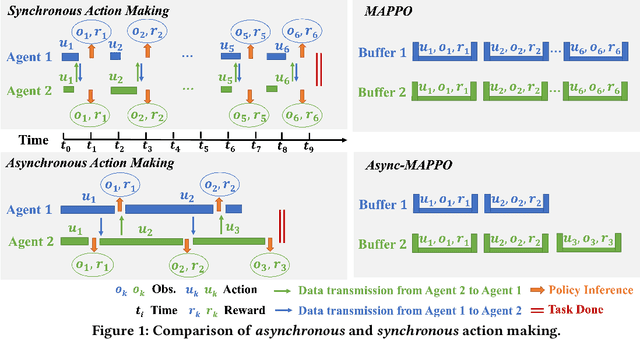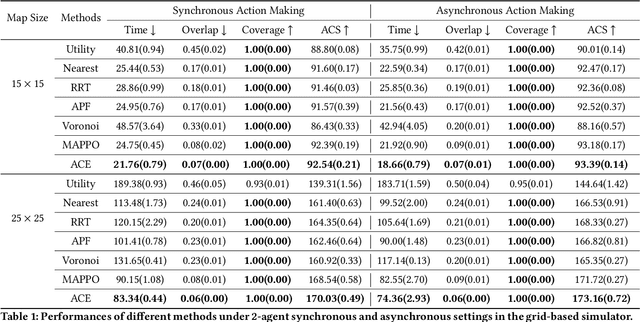Jijia Liu
What Can RL Bring to VLA Generalization? An Empirical Study
May 26, 2025Abstract:Large Vision-Language Action (VLA) models have shown significant potential for embodied AI. However, their predominant training via supervised fine-tuning (SFT) limits generalization due to susceptibility to compounding errors under distribution shifts. Reinforcement learning (RL) offers a path to overcome these limitations by optimizing for task objectives via trial-and-error, yet a systematic understanding of its specific generalization benefits for VLAs compared to SFT is lacking. To address this, our study introduces a comprehensive benchmark for evaluating VLA generalization and systematically investigates the impact of RL fine-tuning across diverse visual, semantic, and execution dimensions. Our extensive experiments reveal that RL fine-tuning, particularly with PPO, significantly enhances generalization in semantic understanding and execution robustness over SFT, while maintaining comparable visual robustness. We identify PPO as a more effective RL algorithm for VLAs than LLM-derived methods like DPO and GRPO. We also develop a simple recipe for efficient PPO training on VLAs, and demonstrate its practical utility for improving VLA generalization. The project page is at https://rlvla.github.io
Hysteresis-Aware Neural Network Modeling and Whole-Body Reinforcement Learning Control of Soft Robots
Apr 18, 2025Abstract:Soft robots exhibit inherent compliance and safety, which makes them particularly suitable for applications requiring direct physical interaction with humans, such as surgical procedures. However, their nonlinear and hysteretic behavior, resulting from the properties of soft materials, presents substantial challenges for accurate modeling and control. In this study, we present a soft robotic system designed for surgical applications and propose a hysteresis-aware whole-body neural network model that accurately captures and predicts the soft robot's whole-body motion, including its hysteretic behavior. Building upon the high-precision dynamic model, we construct a highly parallel simulation environment for soft robot control and apply an on-policy reinforcement learning algorithm to efficiently train whole-body motion control strategies. Based on the trained control policy, we developed a soft robotic system for surgical applications and validated it through phantom-based laser ablation experiments in a physical environment. The results demonstrate that the hysteresis-aware modeling reduces the Mean Squared Error (MSE) by 84.95 percent compared to traditional modeling methods. The deployed control algorithm achieved a trajectory tracking error ranging from 0.126 to 0.250 mm on the real soft robot, highlighting its precision in real-world conditions. The proposed method showed strong performance in phantom-based surgical experiments and demonstrates its potential for complex scenarios, including future real-world clinical applications.
LLM-Powered Hierarchical Language Agent for Real-time Human-AI Coordination
Jan 09, 2024



Abstract:AI agents powered by Large Language Models (LLMs) have made significant advances, enabling them to assist humans in diverse complex tasks and leading to a revolution in human-AI coordination. LLM-powered agents typically require invoking LLM APIs and employing artificially designed complex prompts, which results in high inference latency. While this paradigm works well in scenarios with minimal interactive demands, such as code generation, it is unsuitable for highly interactive and real-time applications, such as gaming. Traditional gaming AI often employs small models or reactive policies, enabling fast inference but offering limited task completion and interaction abilities. In this work, we consider Overcooked as our testbed where players could communicate with natural language and cooperate to serve orders. We propose a Hierarchical Language Agent (HLA) for human-AI coordination that provides both strong reasoning abilities while keeping real-time execution. In particular, HLA adopts a hierarchical framework and comprises three modules: a proficient LLM, referred to as Slow Mind, for intention reasoning and language interaction, a lightweight LLM, referred to as Fast Mind, for generating macro actions, and a reactive policy, referred to as Executor, for transforming macro actions into atomic actions. Human studies show that HLA outperforms other baseline agents, including slow-mind-only agents and fast-mind-only agents, with stronger cooperation abilities, faster responses, and more consistent language communications.
Asynchronous Multi-Agent Reinforcement Learning for Efficient Real-Time Multi-Robot Cooperative Exploration
Jan 09, 2023



Abstract:We consider the problem of cooperative exploration where multiple robots need to cooperatively explore an unknown region as fast as possible. Multi-agent reinforcement learning (MARL) has recently become a trending paradigm for solving this challenge. However, existing MARL-based methods adopt action-making steps as the metric for exploration efficiency by assuming all the agents are acting in a fully synchronous manner: i.e., every single agent produces an action simultaneously and every single action is executed instantaneously at each time step. Despite its mathematical simplicity, such a synchronous MARL formulation can be problematic for real-world robotic applications. It can be typical that different robots may take slightly different wall-clock times to accomplish an atomic action or even periodically get lost due to hardware issues. Simply waiting for every robot being ready for the next action can be particularly time-inefficient. Therefore, we propose an asynchronous MARL solution, Asynchronous Coordination Explorer (ACE), to tackle this real-world challenge. We first extend a classical MARL algorithm, multi-agent PPO (MAPPO), to the asynchronous setting and additionally apply action-delay randomization to enforce the learned policy to generalize better to varying action delays in the real world. Moreover, each navigation agent is represented as a team-size-invariant CNN-based policy, which greatly benefits real-robot deployment by handling possible robot lost and allows bandwidth-efficient intra-agent communication through low-dimensional CNN features. We first validate our approach in a grid-based scenario. Both simulation and real-robot results show that ACE reduces over 10% actual exploration time compared with classical approaches. We also apply our framework to a high-fidelity visual-based environment, Habitat, achieving 28% improvement in exploration efficiency.
 Add to Chrome
Add to Chrome Add to Firefox
Add to Firefox Add to Edge
Add to Edge